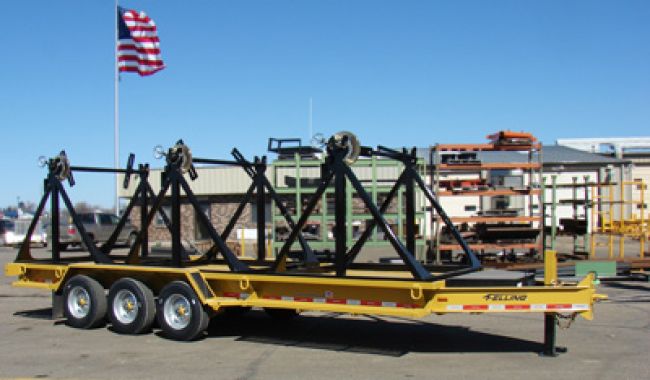
3 Problems to Avoid When Spec’ing a Cable Reel Trailer
When it comes to installing cables, pipes and the like, cable reel trailers can help utility and telecom crews boost productivity and efficiency so they can get more done in less time and for a lower cost of operation. That is, of course, assuming that they’ve selected the right equipment for the job.
Considering most cable reel trailers can last at least 10 years – or possibly even up to 20 if properly maintained – careful thought and consideration should be put into spec’ing the right unit prior to purchase. Not doing so could mean the difference between spending thousands of dollars or tens of thousands of dollars.
According to Mark Rapp, product manager for utility and telecom products for Felling Trailers (www.felling.com), the price of reel trailers varies greatly depending on weight-carrying requirements and the options the trailers are equipped with.
For example, a simple single reel trailer that can haul a 3,000-pound reel can start as low as $3,000, while a three-reel trailer – set up to haul 10,000-pound reels and loaded with options such as hydraulic payout/take-up assemblies and tensioning brakes – can be $65,000, he explained.
Donnie Bright, business development manager for Sherman + Reilly (www.sherman-reilly.com), had a similar response, noting that cost is influenced by the scope of work desired.
“Cost of ownership is very minimal if the cable reel trailer is sized and used correctly,” he said. “Keep your trailer properly maintained per the manufacturer’s maintenance schedule. The life cycle will vary, but if properly maintained and only slightly abused, you should see a minimum 10 to 20 years of service on a quality-built trailer.”
Spec’ing Problems and Pointers
Rapp and Bright shared some of the most common spec’ing problems they’ve seen, and they offered pointers for spec’ing the right cable reel trailer for your fleet operation.
Problem 1: The spec factors in the wrong reel size.
For Rapp, identifying the incorrect reel size is by far the biggest mistake he’s seen customers make when spec’ing a trailer.
“A reel-carrying assembly rated to haul a 60-inch-wide reel that weighs 6,000 pounds may not be rated to haul a 48-inch-wide reel that weighs the same,” he said. “The narrower reel centers more weight to the center of the reel bar, whereas the wider reel’s weight is closer to the carrier. So it’s important to know the range of reel sizes that are going to be hauled.”
Problem 2: Center holes are not compatible with reel bars.
Another issue Rapp identified pertains to the center hole in a reel through which the reel bar passes. The majority of reels have center holes that range from 3 to 3.125 inches. “We provide the largest diameter reel bar that will pass through,” he said. “There are some instances when the reels have smaller holes and smaller diameter reel bars can be supplied. Large diameter holes up to 5 inches can be found on innerduct and large diameter steel and wood reels. In these instances, a tapered adapter can be supplied that slides over the standard reel bar.”
Problem 3: Selecting trailers that are not designed for highway use.
The most common problem Bright sees is companies purchasing reel trailers that are not designed or rated to transport reels on the highway, and the purchasers are unaware that the trailers can’t be used to transport reels. After deciding on the maximum size of the reels to carry, be sure the chosen trailer can carry the maximum rated reel at normal highway speeds, Bright advised.
Max It Out
To get even more use out of your cable reel trailer, Rapp suggested opting for a unit that has bolt or reel stand assemblies.
“Most reel trailers are built for a specific purpose,” he said. “When they aren’t being used, they sit. When the trailer is not being used in the reel trailer capacity, you can remove the reel stands and have a functional flatbed trailer.”
About the Author: Grace Suizo has been covering the automotive fleet industry since 2007. She spent six years as an editor for five fleet publications and has written more than 100 articles geared toward both commercial and public sector fleets.
*****
Ask the Right Questions
What is the best approach to properly spec a cable reel trailer? Here are some questions to help guide you to your final selection.
• What type of operation is being performed? Is it an underground or overhead conductor application? “There are several ways to spec these out,” Rapp said. “In some applications, you may want speed. In other applications, a strong line pull rating may be needed. There are many options available depending on the application. For instance, rollers can be provided along the floor of the trailer in an underground conductor application to maintain the integrity of the insulation surrounding the conductor. You don’t want to damage it by dragging it along the floor.”
• Do you want to transport the reel from yard to job site? “If so, be sure the trailer manufacturer rates the trailer to be used to transport maximum size reel in highway conditions,” Bright said.
• How many reels will need to be hauled at the same time?
• What is the maximum reel weight, width and height you would like to handle with the trailer? Diameter, width, weight and arbor hole size are important.
• What truck size/class is needed to tow the trailer with the maximum size rated reel?
• Does the trailer need to be self-loading? “In this application, a forklift or crane will not be needed to load a reel,” Rapp said. “The trailer reel bar hydraulically lowers to pick up a reel and then raises it to a locked position to be transported. Many of the same options available on a standard reel trailer can be applied to a self-loading one.”

